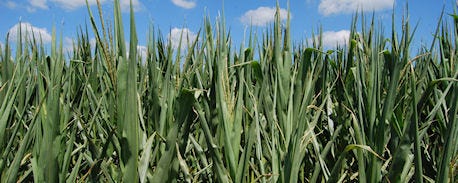October 21, 2012

The USDA Risk Management Agency will release the final fall harvest prices for Revenue Protection crop insurance policies on November 1. As of October 18, those harvest prices are near $7.50 per bushel for corn and $15.33 per bushel for soybeans.
"These harvest price numbers are the final piece of information to finalize potential indemnity payments for Revenue Protection crop insurance coverage," explains Steve Johnson, an Iowa State University Extension farm management specialist. Iowa farmers insured 92% of the corn acres and 91% of the soybean acres in 2012.
Johnson provides the following explanation of how the crop insurance payment will be figured for 2012 production.

ASK IF YOU HAVE QUESTIONS: "It's important for producers who've had crop losses in 2012 to understand their crop insurance coverage and the calculations used to determine crop insurance indemnity payments," says ISU's Steve Johnson. "If you have questions, always ask your crop insurance agent. Keep those lines of communication open."
Many farms will be getting crop insurance payments for 2012
Many Iowa farms that suffered significant production losses in 2012 will receive indemnity payments over the next few months reflecting these harvest prices, notes Johnson. Both the December corn futures price and the November soybean futures price have increased between the projected price (determined in February) and the harvest price (determined in October). These two periods are used in determining the crop insurance payment for Revenue Protection policies.
Should a production shortfall occur, that loss would be compensated at the higher harvest price. Farms that chose to insure their crops with a Yield Protection policy may also receive an indemnity payment for yield losses, but the loss will be paid at the February price level.
Many farmers use Revenue Protection coverage along with pre-harvest marketing strategies and commit a portion of their guaranteed bushels to delivery. "This harvest price is critical if any lost production must be replaced at higher market prices for on-farm feeding or to fulfill delivery on a forward cash or hedge-to-arrive grain contract," he says.
That brings up another question: How do you handle a shortfall of contracted bushels? Hit hard by drought this year, some farmers won't be able to deliver the amount of grain they have promised to deliver on a contract. "Once farmers realize that they cannot deliver all the bushels they've contracted," says Johnson, "they should work with the grain merchandiser on a strategy to make up the shortfall in bushels or pay the replacement value of those bushels."
Example shows how crop insurance payments are determined
To illustrate how crop insurance indemnity payments are determined, Johnson provides an example using Revenue Protection or RP coverage for corn.
2012 Revenue Protection example: A loss occurs when the bushels of corn produced for the unit fall below the production guarantee as a result of damage from a loss that is covered by the policy. This example assumes 175 bushels per acre APH yield, 75% coverage level and basic unit coverage. The figures used in this example are on a per acre basis. Note that guarantees and losses paid are often on a unit basis. Check the provisions of your individual crop insurance policy.
First, multiply 175 bushels per acre (175 x .75) which equals a 131.3 bushel guarantee. If 100 bushels per acre were actually produced, then 131.3 bushels minus 100 bushels equals a 31.3 per acre loss. The 31.3 per acre loss multiplied by the $7.50 per bushel (harvest price determined in October) equals a $234.75 net indemnity.
1) 175 bushel per acre times .75 = 131.3 bushel guarantee*
2) 100 bushel per acre minus 131.3 bushels = 100 bushels = 31.3 bushel per acre loss
3) 31.3 bushel loss times $7.50 per bushel price = $234.75 net indemnity*
* Figures shown on a per acre basis. Guarantees and losses are paid on a unit basis. See individual policy provisions.
Summary: As long as the farmer in this example did not commit to delivery more than the 131.3 bushels per acre he or she should have adequate funds to make up the shortfall in bushels or pay the replacement value of those bushels, notes Johnson.
Delaying settlement beyond early November leaves farmers in a speculative position for those bushels that they were unable to deliver. "Should the futures price move even higher beyond this time frame, the replacement cost to provide those bushels would increase," he says. "Regardless, the need to work with your grain merchandiser is critical should you fall short on contracted bushels."
Johnson adapted this information from USDA RMA's 2012 Commodity
Insurance Fact Sheet for Corn--Crop Revenue Coverage, January 2012.
You May Also Like




